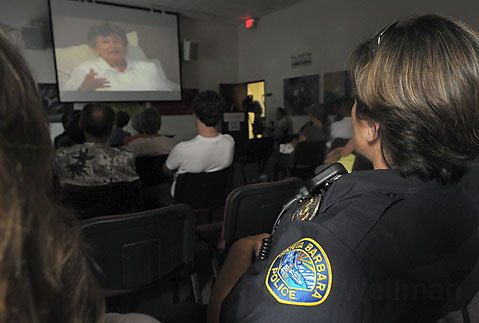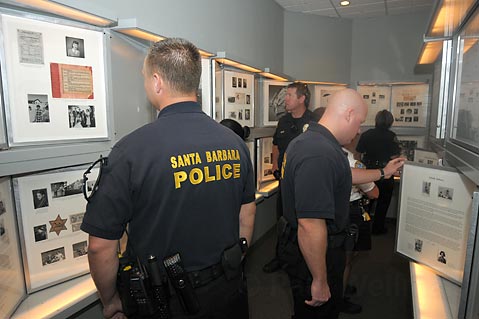S.B. Police Chief Wants Cops to Learn from Holocaust Survivors
A Bridge to Empathy

Elie Weisel, perhaps the most celebrated holocaust survivor, said in an interview in the July-August issue of Foreign Policy Magazine, “A fanatic is someone who doesn’t listen to [anything] but his own ideas. A fanatic never has any questions, only answers.” In an effort to curtail the kind of fanaticism from which the Holocaust was born, groups and individuals worldwide have worked tirelessly throughout the past decades to promote understanding and empathy between different peoples. While important for avoiding the extreme situation of genocide, understanding and empathy also play a vital role in the context of day-to-day life by nurturing better relationships between local factions. This is the kind of communication sought by the Jewish Federation of Greater Santa Barbara through its Portraits of Survival program.
Portraits of Survival: Life Journeys During the Holocaust and Beyond is a permanent exhibit of pictures and personal narratives from people who survived the Holocaust and eventually found themselves in Santa Barbara, as well as an educational program that features survivors who speak with groups of all ages and backgrounds about living through the Holocaust and making a life afterward. Every Holocaust survivor in town (there are about 45) has an intense story to tell; the fact that they are even alive is a testament to the human will to endure any hardship. After persevering despite the horrors of Nazi-occupied Europe, they still faced formidable challenges. Having lost family members-some had no family left at all-the odds stacked against success for these individuals, some were forced to continue running as the government changed from Nazi to communist, others, migrating to the United States, Canada, and Israel, faced language and culture barriers.
The common thread running through all of these stories is a certain optimism and refusal to give up even when placed in the worst scenarios. “I’m a survivor of the Nazis, and also an escapee from communism, so I’m a double dipper,” George Rusznak told a group of Santa Barbara Police officers who came to tour the Portraits of Survival exhibit and listen to some of the survivors tell their stories. “I don’t think of myself as a survivor. I think I live a pretty charmed life.”
Other survivors-such as Helga Carden, an assimilated German Jew who bade her father goodbye for the last time in 1939, when her parents put her on one of a limited number of children’s transports to France-noted that the experience forevermore changed the way she related to other people. “I became a loner and self-sufficient,” she said. “I don’t make any deep attachments because when you lose everyone at a young age, you don’t feel very safe getting attached to people.” Despite her hardships, she was able to complete nursing and anesthesiology school, creating a successful career and having her own family.

Community Outreach
Designed to share the survivors’ extreme prison camp rags-to-new-world riches stories with the public and cultivate awareness between people from different backgrounds, the Jewish Federation has found that the group they have been able to reach in an especially meaningful way is at-risk youth. This is what got Santa Barbara Police Chief Cam Sanchez-himself an immigrant from Juarez, Mexico, who came to the U.S. with the disadvantage of not knowing how to speak any English-interested in the program. He has since been sending groups of his police officers to the Jewish Community Center on Chapala Street to experience the exhibit and talk to the survivors. “It was a personal connection for me, and I really just wanted to share it with my cops,” he said. “Yeah I’m a cop, but in our holistic approach to dealing with youth violence, we need to approach the respected elders of our community.” What better elders, he reasoned, than those who had endured a degree of violence and suffering never experienced by most people.
Chief Sanchez has been actively involved in getting troubled kids to attend the program, an effort that the Jewish Federation has embraced wholeheartedly. “Gang members have been very willing to participate-they’re not ordered to go to this,” said Sanchez. Marveling at the silence that existed in the Jewish Federation’s portrait hall as gang members and at-risk youth read intently the stories of Holocaust survivors who live in their own community, Sanchez added, “You could hear a pin drop.” He said that many of the people who participate in the program are immigrants, so hearing about the struggles of other immigrants who started with the pain of a traumatic experience and then went on to live great lives can be inspiring to them. “They really felt that it only happens to them, and all of a sudden they’re tearing up and saying, ‘Oh my God, it’s not just me!'”
Sharing Portraits of Survival with his officers has been Sanchez’s way to bridge the gap between the police and the troubled youth with whom they often come into contact. He said that it promotes empathy between cops and youth, and even between a few of the members of rival gangs. “This is really one of the biggest outreach programs I’ve ever seen,” said Sergeant Mike McGrew, one of the Santa Barbara Police officers who visited the exhibit and listened to survivors tell their stories in person. “It has a big effect when kids look at this kind of stuff.”
Like the troubled youngsters who had toured the exhibit before them, the officers accompanying McGrew fell silent as they filed through the somber environs of the portrait hall. “We hope that you will walk out of here with something to share with the community,” Dr. Elizabeth Wolfson, the director of the Portraits of Survival program, said to the police officers. “The idea is to convey a story that is meaningful to each and every person who hears it.”
Chief Sanchez said that he intends to continue sending police officers to the exhibit, and connecting at-risk youth with the opportunity to learn about the troubles experienced by others. “Portraits of Survival continues to help us as a police department as a great tool for teaching tolerance.”
4•1•1
For more information about Portraits of Survival events, call the Jewish Federation of Greater Santa Barbara/Bronfman Family Jewish Community Center at 957-1115, or visit jewishsantabarbara.org.



